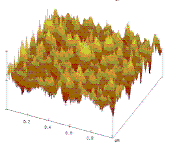Chemical and Biomolecular Research Papers -- Faculty Authors Series

Anuradha Subramanian Publications
Document Type
Article
Date of this Version
September 2007
Abstract
Silicon (100) wafers, predipped in 1:20 (v/v) HF water, were treated separately with four different acid mixtures, viz., HNO3, H2SO4–H2O2, HNO2–HF, and H2SO4–H2O2–HF, for different time durations. Subsequent vigorous rinsing with deionized water rendered the wafer surfaces with hydroxyl termination. Synthesized surfaces were characterized by diffuse-reflectance infrared Fourier transform spectroscopy (DRIFTS), ellipsometry, contact angle and atomic force microscopy. Surfaces treated with HN03 and H2SO2–H2O2 showed increasing hydrophilicity at room temperature due to the formation of silanol (−SiOH) terminated chemical oxides, with continuous oxide growth. An increase in hydrophilicity was observed during the first 15 min of treatment with HNO3–HF and H2SO4–H2O2–HF acid mixtures, causing a decrease in the hydrophilic character with longer incubation times. DRIFTS analysis confirmed the addition of HF in the oxidizing acid mixture controls chemical oxide proliferation, through creating a surface with mixed −SiOH and silicon hydride (−SiHx) termination. Prolonged incubation in acidic mixtures containing HF resulted in a logarithmic increase of −SiHx coverage, rendering the surface hydrophobic. Incubation for 15 minutes in each of the four acid mixture systems generated surfaces with comparable hydrophilicity, controlled oxide growth and reduced surface roughness.


Comments
Published in Journal of The Electrochemical Society, 154 (11) P136-P146 (2007). Copyright © 2007 The Electrochemical Society. Used by permission.